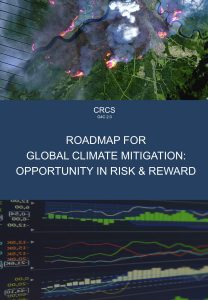Global 4C: A Monetary Policy Response to the Risks of Catastrophic Climate Change
 Latest updates: KSR’s “Carbon Coin”, Global Carbon Reward (new site)
Latest updates: KSR’s “Carbon Coin”, Global Carbon Reward (new site)
Background and context
Since early 2014, we have collaborated with Dr. Delton Chen—an Australian Civil Engineer with a Ph.D. in Geo-Hydrology for work on the Great Barrier Reef—in the development of the “Global 4C Risk Mitigation Policy”, where 4C stands for “Complementary Currencies for Climate Change.” The essence of the Global 4C proposal is to use the monetary-policy role of global financial institutions and national central banks to incentivize verified carbon-reduction and sequestration projects through a kind of “green quantitative easing” strategy, which pumps more money into carbon drawdown projects in a currency that can be readily exchanged with the national currency wherever the projects are being done.
Note: A number of newly-elected U.S. representatives, have recently proposed a program of central bank Quantitative Easing to finance a zero carbon economy. This development confirms that the approach of Carbon Quantitative Easing (CQE), under the Global 4C, is politically feasible.
The Risk Management Plan
 At the heart of the Global 4C policy is a new economic theory that redefines the standard economic model for pricing carbon emissions. The standard model is to assess the social cost of carbon emissions, but the new model is to include a risk-cost of carbon emissions, which is comparable to the cost of a global insurance policy that can prevent catastrophic climate change. The Global 4C proposal is to mandate national central banks with a new monetary-policy that can incentivize verified carbon-reduction and sequestration projects through a kind of “green quantitative easing” strategy, which pumps more money into successful carbon drawdown projects as part of a risk management plan. If implemented, the 4C currency will be readily exchanged with the national currency wherever the projects are being done.
At the heart of the Global 4C policy is a new economic theory that redefines the standard economic model for pricing carbon emissions. The standard model is to assess the social cost of carbon emissions, but the new model is to include a risk-cost of carbon emissions, which is comparable to the cost of a global insurance policy that can prevent catastrophic climate change. The Global 4C proposal is to mandate national central banks with a new monetary-policy that can incentivize verified carbon-reduction and sequestration projects through a kind of “green quantitative easing” strategy, which pumps more money into successful carbon drawdown projects as part of a risk management plan. If implemented, the 4C currency will be readily exchanged with the national currency wherever the projects are being done.

This risk management plan should support the 2015 Paris Agreement (COP21). A study published in Nature (July 24, 2017), indicates that we may have less time to address the climate crisis than previously thought, because of some uncertainty as to how quickly greenhouse gases have accumulated in the atmosphere since the pre-industrial era. A related story in Scientific American (July 25, 2017) states “A new global temperature baseline casts doubt on humanity’s ability to meet the Paris target.”
Our Role

Our role has been that of a US-based nonprofit “policy host” for the proposal. In that capacity we’ve worked with Dr. Chen and EconoVision (Netherlands)to reach out to a global network of scientists, engineers, economists, and entrepreneurs. Our main efforts include the drafting and submission of several grant proposals, most notably the MacArthur Foundation’s 100 & Change; accepting two awards for the proposal from the MIT Climate Collab; co-authoring conference papers and a peer-reviewed academic paper in the Journal of Sustainable Finance and Investment. We also host the Global4C.org web site; and we will continue to present the concept at conferences, such as the MIT SOLVE, and also through the website, video presentations, and public engagements. During the course of this work we’ve had the opportunity to meet and collaborate with a number of globally-prominent figures, all of whom have given us valuable feedback and contacts with others who may be helpful.

Executive Director, Possible Planet
It’s important to understand what a long shot this kind of proposal is in its initial formulation. It seems immediately obvious at one level, but complex and profoundly challenging in a number of ways. Dr. Chen came up with the idea at one of Al Gore’s famous Climate Reality briefings (in Istanbul), and has basically suspended his career for several years in order to work out (a) the details of how it might work, (b) the theoretical underpinnings in physics, economics, and biomimicry that support the idea that it will work, (c) the unique features of the policy, and (d) the widespread recognition and understanding of key players in global climate policy negotiations of how this could provide a significant approach to what is now recognized as the challenge of moving trillions of dollars into addressing the problem.
[bg_collapse view=”button-green” color=”#4a4949″ icon=”arrow” expand_text=”Show More” collapse_text=”Show Less” ]
Solutions for Climate Finance
The relevance of Global 4C to international climate policy is growing, and this is because of recent discussions at the Bank of England, at the Financial Stability Board (G20) and by economists who recommend new mandates for central banks to provide direct climate finance. The U.N. has recently estimated that some $90 trillion dollars need to be invested in carbon drawdown strategies in the next fifteen years, and governments do not have this kind of money, so it needs to come from the private sector. But if governments don’t have the money, then some other policy approaches are needed to entice private investors onto the playing field at a large enough scale. Global 4C will attract the required amount of finance, through the 4C currency, a system of verifiable sequestration and mitigation, and risk-adjusted pricing. This approach will spread the costs to the entire world economy in terms of roughly 1-2% added inflation.
Most recently, a study published in Nature on July 24, 2017, indicates that we may have less time to address the climate crisis than previously thought, because of some uncertainty as to how quickly greenhouse gases have accumulated in the atmosphere since the pre-industrial era. If our baseline assumptions are wrong, and human-caused warming is occurring faster than previously estimated, then the likely impact of the foreseeable pace of emissions may trigger a tipping point much sooner than anticipated. A related story in Scientific American states “A new global temperature baseline casts doubt on humanity’s ability to meet the Paris target.”
Local Actions

Co-Founder, Possible Planet
One of the challenges on a local scale, of course, is that currently there are no incentives or guarantees for carbon-reduction initiatives, so only those projects that are inherently profitable at this time (e.g., clean energy projects) can be readily financed. And to the extent that these are profitable, they don’t really need added incentives. The challenge is with initiatives that may not be profit-making right away, such as building a biochar manufacturing facility, or converting an entire fleet of vehicles to EVs. Especially in developing countries, even profitable projects may have difficulty getting financing. So what’s needed is probably a large enough incentive program to “take out” the financing needed to build the projects, and provide them with long term viability.
Your Interest and Support are Important to this Effort
If you’d like to be involved in some capacity, please contact Victoria Zelin at vzelin@possibleplanet.org. If you’d like to ask technical questions about Global 4C, please email us at global4c@gmail.com, follow the links in this article, and watch for further presentations of the strategy at upcoming conferences by Dr. Chen and other collaborators. We’ll also be updating the story on a regular basis, as Global 4C is our primary “planet-scale” solution for global climate change, which threatens not only us but much if not all of vertebrate life that has evolved along with us over the past 250 million years.
DONATE TO OUR GLOBAL4C APPEAL TODAY
References
Chen, D.B., van der Beek, J. and Cloud, J., 2017. Climate mitigation policy as a system solution: addressing the risk cost of carbon. Journal of Sustainable Finance & Investment, 7 (3): 1-42.
[/bg_collapse]

